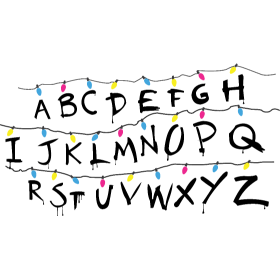Stranger Things

There is, usually, much to be said about the early 80s. The Golden age hits of synthesizer music and energetic anthems, with big hair and tight clothes to epic guitar solos and incredible voices. A decade of charm and good songs. Unfortunately, today this fascinating period does not longer interest people of my same age, the "Millennials". But, the Netflix platform has come to help. Its latest original series "Stranger Things" pays a perfect homage to that beautiful time. In fact, it delivers a shot of surprise and nostalgia right to the heart of both the youngest and oldest viewers. Brought to life by stars like Winona Ryder and Matthew Modine alongside a cast of young unknown actors, the narrative begins on November 6th 1983 in a small town in Indiana called "Hawkins". When a 12-years-old boy named Will Byers vanishes mysteriously, his frantic mother, Joyce, searches for him while Police Chief Jim Hopper launches his own secret investigation. Will's friends Dustin, Mike, and Lucas befriend a psychokinetic girl whose name is Eleven, who claims to know Will's location. As they uncover the truth, a sinister government agency tries to cover it up, while a more insidious force lurks below the surface. What makes this show extraordinary is the fact that it is deeply infused with the influences of the 80's. There are screen references to Spielberg's movies (including E.T and the Poltergeist), to famous blockbusters such as Star Wars and The Goonies, and references to the Stephen King's novels (such as Salem's Lot, Carrie and Shining) that create an exquisite pleasure for viewers. However, there is another reason that made both the critics and the audiences enthusiastic about Stranger Things: its impressively creative editing transitions. Not only a simple dissolve or a fade to black. In this show transitions can be much more interesting. This happened because, as one of the editors of the show, Dan Zimmerman, has said: "We basically treated the entire series as this big feature film that we broke up into what was considered back in the old days "reels." For us, it was great because we did all our mixing and color-timing on the back end once all the episodes were locked and completed and all the visual effects were done". This strategy allowed them that flexibility of being able to watch the entire series and go back into respective episodes and really fine-tune this basically eight-hour movie, which helped a lot the storytelling. And one of the editing transitions used that really improved the storytelling was the "graphic match". By its very definition, the graphic match is a device used in the continuity editing that occurs when two shots are cut together that contain similar shapes in similar positions within the frame. This transition is simple and straightforward, but can be both stylish and effective. Stranger Things is full of this technique, especially when characters have flashbacks of their past. There are several important scenes where the graphic match is applied to the flashbacks, however one of the most important is that when when Eleven is walking through the store and has a flashback of being brought into the laboratory wherein she was imprisoned. But because this show is revolutionary and exciting, throughout all the episodes it is not just used the graphic mach, but also the "contrast cut", a device of the discontinuity editing. Contrast cuts transition from one extreme to another, hitting the viewer emotionally and physiologically in an unexpected way. And the more edgy these types of transitions are, the more popular they become. In the series this type of transition is used towards flashbacks too. So, if the graphic match helps the viewer to understand a character’s particular memory, because thorough details it helps the audience to comprehend why the character is having that particular emotion and memory and that time, the contrast cut does the opposite. It creates a puzzle. It makes the flashbacks get a little longer, showing more of the big picture. The opinions on the truth change as new information is learned, and even more questions are created. The viewer thought he was on the right path to know what was going on in this sleepy little town, but now he’s no longer sure. What had seemed "so obvious," is not anymore. In addition to this, there is another interesting aspect of the show linked together to the editing: the audio. The audio plays a huge role in the happening of transitions; in fact if we watched the same scenes on mute, all the transitions would fall flat. In a couple of edits, the audio transition starts to happen even a few frames before the actual video edit begins. This happens because, according to Academy Award-winning film editor Walter Murch, this way of editing often feels more natural. In real life, in fact, we hear things and then react to them, usually by turning our heads. So we are almost always "hearing" the transition before we visually process it. To conclude we could state that, due to all these amazing features, Stranger Things is a true masterpiece. Netflix's little beauty that combines a distribution model that represents the future of the screen entertainment with content that harks back to its past.